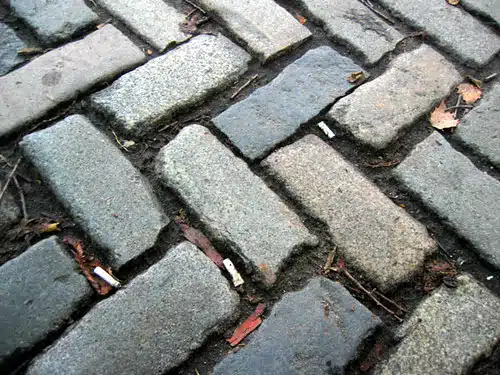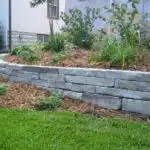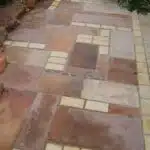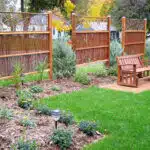Creating a stone sidewalk or garden path is a great way to add both functionality and beauty to your outdoor space. A well-designed pathway can enhance the aesthetic appeal of your garden, while also providing an easy and safe way for you and your guests to navigate through the area.
When it comes to building a stone walkway, there are several factors to consider, such as choosing the right materials, determining the best location, and ensuring proper drainage. With careful planning and attention to detail, however, you can create a stunning pathway that will not only serve its practical purpose but will also bring joy and satisfaction to those who use it. In this article, we will provide expert advice on how to plan and construct a stone sidewalk or garden path that is both functional and visually appealing.
Choosing The Right Stone For Your Pathway
Stone pathways are a beautiful addition to any garden or landscape design. When it comes to choosing the right stone for your pathway, there are several factors to consider. One of the most important considerations is the type of stone you choose. There are many types of stone available, including limestone, flagstone, and granite.
Each type of stone has its own unique properties and characteristics that make it suitable for different applications. For example, limestone is a popular choice for paths because it is durable and easy to work with. Flagstone, on the other hand, is known for its natural beauty and can be used to create a more rustic look. Granite is another popular option because it is extremely durable and comes in a variety of colors.
Another important factor to consider when choosing the right stone for your pathway is color coordination. The color of your stone should complement the surrounding landscape and architecture. Neutral colors like gray or beige are versatile options that can work well with many different styles, while brighter colors like red or green can add a pop of color and create a more dramatic effect.
When calculating the amount of materials needed for your project, it’s important to take into account the size of your pathway as well as any curves or angles. By carefully selecting the right type of stone and coordinating colors effectively, you can create a stunning pathway that enhances your outdoor space and adds value to your property.
Calculating The Amount Of Materials Needed
After selecting the right stone for your pathway, it’s time to move on to the next crucial step of building a stone sidewalk or garden path. This step involves determining the amount of materials you will need for your project. According to a recent survey, the average cost of building a stone pathway is around $2,500. However, this cost can vary depending on various factors such as size, material selection, and design complexity.
To ensure that you have all the necessary materials in hand before starting your project, here are five key items to consider:
- Measure the length and width of the area where you want to build your pathway.
- Calculate the amount of stone needed based on the dimensions of your pathway.
- Estimate how much sand and gravel you will require for leveling and filling gaps between stones.
- Decide whether or not you want to install edging along with your pathway.
- Determine if any additional tools or equipment will be required such as gloves, safety glasses, shovels, wheelbarrows etc.
Material selection is also an essential aspect when building a stone sidewalk or garden path. Some common materials include flagstone, slate, granite and limestone. Each type of material has its unique features that make it suitable for different landscape designs. For instance, flagstone is ideal for creating natural-looking pathways while slate offers a more modern appeal.
Now that you have determined what materials you require for your project let’s move onto discussing what tools and equipment are needed to build a beautiful stone sidewalk or garden path.
Tools And Equipment Required
To build a stone sidewalk or garden path, you will require specific tools and equipment. Before purchasing or renting any tool, be sure to understand the safety precautions that come with their usage. Safety should always be the top priority when handling any tool or equipment, especially those that are sharp or heavy.
When it comes to choosing between renting and buying tools, consider the frequency and duration of your project. If you are building a one-time project, renting is an excellent option as it is cost-effective compared to buying tools that you may not need in future projects. However, if you plan on building more than one project or have other uses for the tools later, it may be worth investing in high-quality equipment.
Remember to always prioritize safety when using tools and equipment during the construction process. Be sure to wear protective gear such as gloves and eye protection when handling sharp objects like chisels and hammers. Additionally, ensure that all power tools have safety guards installed before use. With safety precautions in mind, the next step is preparing the site for construction.
Preparing The Site For Construction
Before construction can begin, proper site preparation is essential to ensure a successful outcome. The first step in preparing the site is to clear away any debris and vegetation that may obstruct the pathway. In some cases, it may be necessary to use heavy equipment such as a skid steer loader or excavator to remove large rocks and stumps.
Once the site has been cleared, it’s time to start thinking about landscaping design. Consider the surrounding area and choose materials that will complement existing features such as shrubs, trees, and flowers. It’s also important to take into account factors such as drainage and soil type when selecting materials for the pathway.
To create a visually appealing stone sidewalk or garden path, there are several materials that can be used such as flagstone, cobblestones, or pavers. These materials come in various colors and shapes, allowing you to create a unique design that reflects your personal style. When selecting the type of stone for your pathway, consider factors such as durability and slip resistance.
- Use natural elements such as plants and flowers along the pathway
- Incorporate lighting fixtures for safety and ambiance
- Consider adding seating areas or focal points along the way
- Use contrasting colors or patterns for added visual interest
Now that the site has been prepared and landscaping design has been considered, it’s time to mark out the pathway. This involves using stakes and string to outline where the pathway will be located. Once this has been done, you can begin laying down your chosen material in a pattern that is both functional and aesthetically pleasing. By carefully planning each step of the process, you can create a beautiful stone sidewalk or garden path that will enhance your outdoor living space for years to come.
Marking Out The Pathway
- Careful planning is necessary when laying out and measuring a stone sidewalk or garden path to ensure a successful outcome.
- Guidelines should be set for the path by determining the desired location, width, and length, as well as accounting for any curves or turns in the path.
- Markings should be made to designate the path’s location and the depth at which it will be dug.
- When digging the pathway, the soil should be carefully removed and inspected for any rocks, roots, or other obstructions.
- The depth and width of the pathway should be kept consistent to ensure a stable and even surface when the stones are laid.
- The pathway should be dug in layers to prevent the stones from sinking into the soil.
Layout And Measurement
When it comes to building a stone sidewalk or garden path, layout and measurement are crucial components of the planning process. Design options can vary greatly, from a simple straight path to a more intricate design featuring curves and turns. Regardless of design, it is important to accurately measure the area where the pathway will be installed. This not only ensures that you have enough materials for the job, but also helps to avoid wasting money on excess materials.
Material cost is another important factor to consider when planning the layout and measurement of your stone pathway. Different types of stone will have varying costs, so it is important to research and choose a material that fits within your budget while also complementing your overall landscaping design. Additionally, labor costs should also be taken into account when considering material expenses.
To get started with marking out the pathway, first determine the desired width of the path and mark this distance along both sides of where you want the path to go using stakes and string. Next, use measuring tape or a long piece of wood to draw out any curves or turns in the path. Once you have marked out the entire pathway, double check all measurements before proceeding with installation. Proper layout and measurement at this stage will save time and money in later stages of construction.
Marking Guidelines
Designing and creating a stone pathway or garden path requires careful planning and execution. One crucial aspect of this process is marking out the pathway, which involves determining the desired width, curves, and turns of the path. To ensure accuracy and minimize errors, it is important to follow proper marking guidelines.
When considering design options for your stone pathway, keep in mind that curves and turns can add visual interest and create a more natural-looking path. However, these designs require more precise measurements when marking out the pathway. Using stakes and string to mark the desired width along both sides of where you want the path to go is a good starting point. For curves or turns in the path, use measuring tape or a long piece of wood to draw out these areas accurately.
Material selection is also an important factor in creating a stone pathway. The type of stone you choose will affect not only the cost but also the overall look and feel of your landscaping design. When marking out the pathway, consider how much material you will need to cover the entire area while still fitting within your budget. Proper layout and measurement at this stage will help you avoid wasting money on excess materials later on during installation. By following these marking guidelines, you can create a beautiful and functional stone pathway that enhances your outdoor space while staying within your budget.
Digging The Pathway
After marking out the pathway, the next step is to dig the path. This process involves removing any existing grass or vegetation and excavating the soil to a depth that accommodates the thickness of your chosen stone material. Digging the pathway requires careful planning to ensure that it is level and has proper drainage. It is essential to follow proper guidelines to prevent soil erosion and standing water, which can damage your plants and make the path slippery.
When digging your pathway, consider using a garden edger to create a defined border for your landscaping design. A garden edger helps prevent grass and other vegetation from growing into your pathway while creating an aesthetically pleasing look. Additionally, by digging a few inches deeper than the desired depth of your stones, you can add a layer of gravel or sand to improve drainage in areas with poor soil quality.
To ensure that your pathway remains level throughout its length, use a spirit level or long straight edge as you dig. This will help you avoid any bumps or dips in the finished path that may cause tripping hazards or make it difficult to walk on. With these landscaping ideas and DIY tips in mind, you can confidently start digging your stone pathway and create an inviting outdoor space for yourself and others to enjoy.
Overall, digging the pathway is an essential step in creating a functional stone path that enhances your outdoor space. By following proper guidelines for excavation and leveling, you can ensure that your path not only looks beautiful but also provides safe passage for those who use it. So roll up those sleeves and get started on creating a stunning stone pathway today!
Digging The Trench
Before laying the stones, it is necessary to dig a trench for the sidewalk or garden path. The depth of the trench should be approximately 4-6 inches deep, depending on the size of the stones being used. It is important to dig a straight and level trench to ensure that the final product is even and stable. A common mistake when digging the trench is not taking into account any sloping or uneven ground, which can result in an unstable path.
An alternative method for digging the trench is using a sod cutter, which can make the process quicker and easier. However, this method may not be suitable for all types of soil and ground conditions. It is also important to note that using a sod cutter may result in more damage to existing grass or vegetation in the area.
When digging the trench, it is important to remove any rocks or debris from the area. These obstacles can interfere with placing and leveling the stones later on in the project. Additionally, it is recommended to create a slight slope away from any buildings or structures to ensure proper drainage during rainy weather.
Moving onto installing edging, it’s essential for creating clean edges around your stone walkway or garden path.
Installing The Edging
When installing an edging to a garden or sidewalk, it is important to consider the edging material, shape, and size. The edging should be chosen based on the desired aesthetic, as well as its ability to withstand the elements and pressure. Before installing, the edging should be prepped by removing any dirt or debris and ensuring that it is level. The edging should then be secured in place with the appropriate material such as sand, concrete, or mortar. Depending on the material, edging should be laid in a single or multiple pieces. Once installed, the edging should be checked for levelness and the gaps should be filled with the appropriate material.
Choosing The Edging
When it comes to building a stone sidewalk or garden path, choosing the right edging is crucial. The edging creates a barrier between the path and surrounding landscape, preventing soil and plant material from encroaching on the path. There are several materials to choose from when it comes to edging, each with their own pros and cons.
Materials comparison is essential when deciding on the best edging for your stone path or sidewalk. Some popular options include brick, concrete, metal or plastic strips, and natural stone. Brick offers a classic look that can complement many styles of landscaping, but may be prone to cracking over time. Concrete is durable and easy to work with but can lack aesthetic appeal. Metal or plastic strips are affordable DIY edging options that require minimal maintenance but may not provide enough support for larger stones. Natural stone provides an attractive and sturdy border for your path but can be more expensive than other materials.
DIY edging options are plentiful for those who want to save money on installation costs. A simple trench dug along the edge of the path can serve as an effective barrier against encroaching plants or soil erosion. Additionally, utilizing salvaged materials such as logs or recycled rubber can add an eco-friendly touch to your project while providing solid edging support. Ultimately, choosing the right edging material will depend on factors such as budget, desired aesthetic appeal, and level of maintenance required. By weighing these considerations carefully before beginning your project, you can ensure a beautiful and functional stone walkway that will withstand years of use.
Preparing The Edging
Choosing the right edging material is only the first step in creating a beautiful and functional stone walkway. Preparing the edging is just as important to ensure that it provides adequate support for your stones and maintains its aesthetic appeal over time. One essential step in preparing the edging is to excavate the area along the path, removing any grass or other vegetation that may interfere with your installation. This will also help to create a level surface for your stones, preventing tripping hazards and unsightly gaps.
Another crucial step in preparing the edging is to create a trench or border that will hold your stones securely in place. This can be accomplished using materials such as concrete, brick, or natural stone, depending on your desired aesthetic and budget. Adding aesthetics to your edging can also enhance the overall look of your walkway, creating a cohesive design that blends seamlessly with your landscape.
Finally, before installing your edging and laying your stones, it’s important to make sure that everything is level and secure. This includes checking for any gaps or uneven areas along the path and filling them in with additional soil or packing material. By taking these steps to prepare your edging properly, you can ensure a long-lasting and visually appealing stone walkway that will enhance the beauty of your landscaping for years to come.
Installing The Edging
Installing the edging is a crucial step in creating a beautiful and functional stone walkway. After choosing the right edging material and preparing it properly, it’s time to install it along the path. There are several options for installing edging, depending on your desired look and budget.
One option is to lay the edging directly into the trench or border created during preparation. This can be done with concrete, brick, or natural stone, depending on your preference. Another option is to use decorative options such as metal or plastic edging that can be easily installed with stakes. Cost considerations should also be taken into account when deciding which edging option to choose.
Once you have selected your preferred method of installation, it’s important to ensure that everything is level and secure before laying your stones. This includes checking for any gaps or uneven areas along the path and filling them in with additional soil or packing material if necessary. Taking the time to properly install your edging will not only enhance the overall aesthetic appeal of your walkway but also provide adequate support for your stones over time.
Laying The Base Material
The success of any stone sidewalk or garden path lies in laying a proper base material. The base material is the layer that sits directly underneath the stones and serves as a foundation for the entire structure. Thus, it is important to select the right type of base material based on your project’s specific requirements.
There are different types of base materials to choose from, including crushed rock, gravel, and sand. Crushed rock is an excellent choice for larger projects as it provides excellent drainage and stability. Gravel is another popular option due to its affordability and versatility; it works well with both large and small stones. Sand is commonly used for smaller projects or as a top layer over other materials.
Once you have selected the appropriate base material, ensure that it has been laid at a proper thickness. The depth required will depend on several factors such as soil type, climate conditions, and expected weight load. As a general rule of thumb, four inches of compacted base material should be sufficient for most stone paths. However, you may need to add additional layers if your project requires more support.
Next up: Setting the Stones in Place. Now that you have laid down your base material, it’s time to move on to the exciting part of setting your stones in place!
Setting The Stones In Place
Like puzzle pieces, the stones must be pieced together to create a cohesive and functional path. Careful planning and consideration should go into the design options for your stone sidewalk or garden path. Think about how you will use the path and what style will complement the surrounding landscape.
One cost consideration when setting stones in place is ensuring they are level. Uneven stones can cause tripping hazards and may require future maintenance. Using a leveling tool can help ensure that each stone is set at an even height, reducing the likelihood of accidents.
Another cost consideration is the type of stone used. While natural stones may be more expensive upfront, they often require less maintenance than man-made alternatives. Additionally, natural stones offer a unique look that cannot be replicated by synthetic materials.
As you move forward with setting your stones in place, keep in mind both design options and cost considerations to create an aesthetically pleasing and functional pathway. Next, we will discuss securing the stones to ensure they remain in place for years to come.
Securing The Stones
Once your stones have been laid in place, it is important to secure them to prevent any shifting or movement. This can be done through the use of stone sealers, which not only help to hold the stones in place but also protect them from weathering and staining. It is recommended to apply a sealer once the stones have been cleaned and allowed to dry completely.
Another important aspect of maintaining a stone sidewalk or garden path is proper weeding techniques. Weeds can quickly take over and ruin the aesthetic appeal of your pathway. Hand-pulling weeds regularly is one method, but using an herbicide specifically designed for use on hardscapes can also be effective. Be sure to carefully read and follow all instructions when using any type of herbicide.
In addition to securing the stones and keeping weeds at bay, regular maintenance such as sweeping debris and removing any stains or spills will keep your stone pathway looking its best for years to come. By taking these steps, you can enjoy a beautiful and durable pathway that adds value and functionality to your outdoor space.
To ensure a smooth and level surface, the next step involves filling in the gaps between each stone with either sand or gravel. This will provide stability while also allowing for drainage during rainy weather. Properly filling in these gaps will create a finished look that enhances the overall appearance of your stone pathway.
Filling In The Gaps
After securing the stones in place, it’s time to fill in the gaps. This is a crucial step that will determine the durability and longevity of your stone sidewalk or garden path. There are different jointing techniques that you can use depending on the size and type of stones you have used. The most common method is to sweep or pour fine sand into the gaps between the stones, compacting it as you go along. This creates a stable base for your stones while allowing some flexibility for natural movements.
However, if you want a more polished look or need extra stability, there are alternative materials that you can use. One option is to use polymeric sand, which contains special additives that harden when exposed to moisture. This creates a strong bond between the stones while also preventing weed growth and erosion. Another option is to use mortar or concrete mix, but this should only be done for larger stones or heavy traffic areas.
When filling in the gaps, it’s important to take your time and be thorough. Make sure that all joints are completely filled and level with the surface of the stones. You can use a broom or brush to spread out any excess material and remove any debris from the surface. Once you’re done, give it some time to settle before walking on it or adding any finishing touches.
Next, we’ll discuss adding drainage to your stone sidewalk or garden path. Proper drainage is essential for preventing water buildup and preserving your investment in the long run. We’ll cover different ways of incorporating drainage systems into your design without compromising its aesthetic appeal.
Adding Drainage
To ensure that your stone sidewalk or garden path remains in great condition, it is essential to add proper drainage. If water is allowed to accumulate on the surface of your walkway, it can lead to erosion and damage over time. Therefore, having an effective drainage system is crucial.
One of the most important aspects of creating proper drainage is ensuring that your walkway has a proper slope. This means that the surface should have a gradual slope away from any nearby buildings or structures. A good rule of thumb is to aim for a slope of at least 1/8 inch per foot. This will help to direct any excess water towards designated drainage areas.
Once you have established the appropriate slope for your walkway, it’s time to consider effective drainage solutions. There are several options available depending on the size and location of your walkway. For example, one solution may be to install a French drain system alongside the path. Alternatively, you could opt for a channel drain system or even a simple gravel-filled trench. Whatever solution you choose, make sure that it is adequate enough to handle any potential water buildup and effectively directs excess water away from your walkway.
With proper slope and effective drainage solutions in place, you can rest assured that your stone sidewalk or garden path will remain in great condition for years to come. However, before we move onto applying finishing touches such as edging and landscaping elements, there are still some important considerations left – including how best to maintain your new path over time.
Applying Finishing Touches
After ensuring that your stone pathway has proper drainage, it’s time to start thinking about adding decorative elements and lighting options. These finishing touches can really elevate the look and feel of your garden path or sidewalk. Consider incorporating some landscape edging along the sides of your path to create a more defined border. This can be done with materials such as brick, stone, or metal.
Another way to enhance the appearance of your stone pathway is through the use of lighting. There are various options available, including solar-powered lights, low-voltage LED lights, or even traditional lanterns. Lighting not only adds an aesthetic element but also improves safety by illuminating the path during nighttime hours.
When considering decorative elements and lighting options for your stone pathway, keep in mind the overall style and theme of your garden or landscape design. Choose elements that complement each other and work together harmoniously. With a little creativity and attention to detail, you can create a stunning stone pathway that adds both functionality and beauty to your outdoor space.
Now that you’ve put in all this effort to build a beautiful stone pathway, maintaining it is key to ensuring its longevity. Regular maintenance includes sweeping away debris and fallen leaves, removing weeds that may grow between stones, and periodically pressure washing to remove dirt buildup. By taking these steps, you’ll be able to enjoy your beautiful stone pathway for years to come.
Maintaining Your Stone Pathway
Once your stone pathway is installed, it’s important to maintain it so that it lasts for years to come. One crucial step in maintaining your pathway is sealing the stones. This will protect them from weathering and staining, as well as help prevent the growth of weeds between the stones. It’s recommended to seal your stones at least once a year or whenever you notice the sealer wearing off.
Another key aspect of maintaining your stone pathway is preventing weed growth. Weeds can quickly take over and ruin the look of your pathway if left unchecked. One way to prevent weed growth is by laying down a layer of landscaping fabric underneath the stones when first installing the pathway. This will act as a barrier between the soil and stones, making it more difficult for weeds to grow through. Additionally, regularly pulling any weeds that do appear will help keep them under control.
By following these maintenance tips, you can ensure that your stone pathway remains beautiful and functional for years to come. However, if you do encounter any issues along the way, don’t worry – there are solutions available. In our next section, we’ll cover some common issues that may arise with stone pathways and how to troubleshoot them effectively.
Troubleshooting Common Issues
One of the most common issues that arise with stone sidewalks or garden paths is the growth of weeds. Weeds can quickly overtake the spaces between the stones, making it difficult to maintain a clean and tidy appearance. Fortunately, there are several solutions to this problem. One option is to use a weed barrier fabric beneath the stones during installation. This will prevent weeds from germinating and growing in the first place. Alternatively, regular weeding and application of herbicides can keep weed growth under control.
Another issue that may occur with stone walkways is erosion. This can happen when heavy rain or foot traffic causes soil to wash away from around the stones, leaving them unsupported and unstable. To prevent erosion, it is essential to ensure proper drainage during installation. The path should be sloped slightly away from any structures or plantings, so water flows away from them instead of pooling around them. Additionally, adding edging along the sides of the path can help keep soil in place and prevent erosion.
In conclusion, while stone sidewalks or garden paths are beautiful additions to any landscape design, they do require some maintenance and care over time. By taking steps to address common issues such as weed growth and erosion prevention during installation and regular upkeep, these paths can remain functional and visually appealing for years to come. With proper planning and attention to detail, anyone can enjoy a lovely stone pathway that adds value and beauty to their outdoor space.
Conclusion
Building a stone sidewalk or garden path can be a great addition to any landscape design. By following the steps outlined in this article, you can create a beautiful and functional pathway that will last for years to come.
Choosing the right stone is an important first step in the construction process. Consider factors such as durability, color, texture, and size when making your selection. Calculating the amount of materials needed and preparing the site properly are also critical to ensuring a successful project.
One anticipated objection to using stone as a pathway material may be its cost compared to other options such as concrete or gravel. However, it is important to remember that stone offers unique aesthetic qualities and longevity that may make it worth the investment in the long run. Additionally, there are various types of stone available at different price points, so there is likely an option that will fit within your budget.
Overall, building a stone pathway requires careful planning and attention to detail, but with the right tools and techniques, it can be a rewarding DIY project or an excellent addition to your landscaping services portfolio. Proper maintenance will ensure that your pathway remains safe and attractive for years to come.
Image Credits
- “Stone sidewalk” by rpongsaj (featured)





![Calculating How Much Stone Dust You Need 5 [Blog Post]Stone Dust © Oxfam Australia](https://green-life.blog/wp-content/uploads/2023/05/GdZVzgTqPhjq-150x150.jpg.webp)























